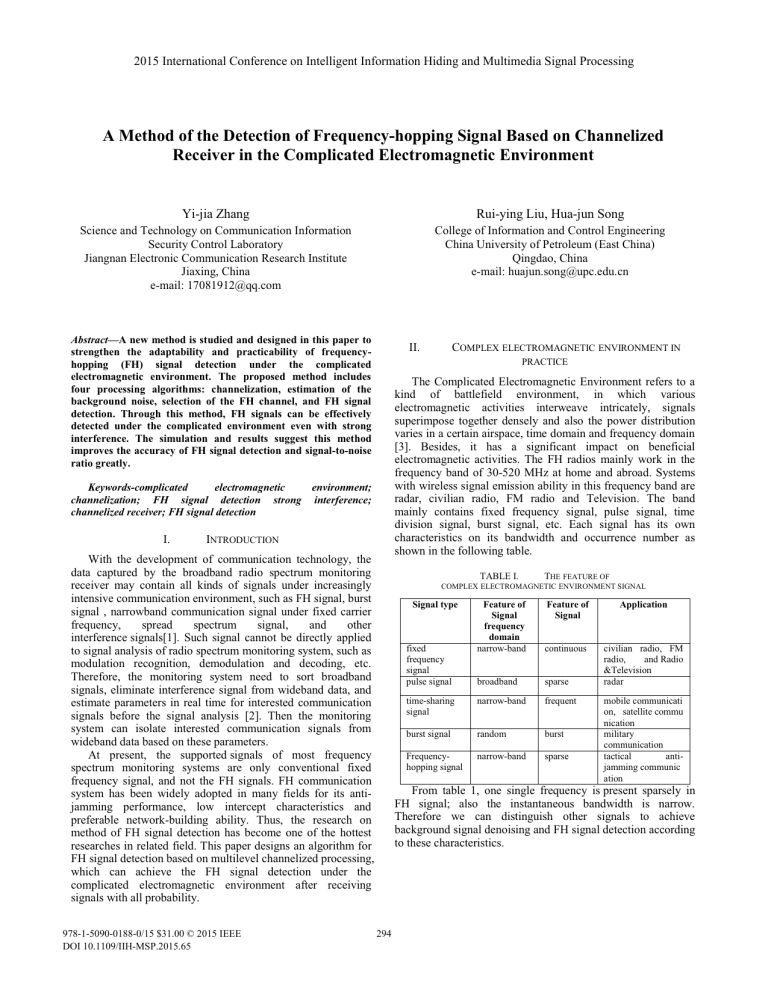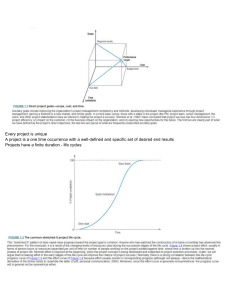FH Signal Detection in Complicated Electromagnetic Environments
advertisement

2015 International Conference on Intelligent Information Hiding and Multimedia Signal Processing A Method of the Detection of Frequency-hopping Signal Based on Channelized Receiver in the Complicated Electromagnetic Environment Yi-jia Zhang Rui-ying Liu, Hua-jun Song Science and Technology on Communication Information Security Control Laboratory Jiangnan Electronic Communication Research Institute Jiaxing, China e-mail: 17081912@qq.com College of Information and Control Engineering China University of Petroleum (East China) Qingdao, China e-mail: huajun.song@upc.edu.cn Abstract—A new method is studied and designed in this paper to strengthen the adaptability and practicability of frequencyhopping (FH) signal detection under the complicated electromagnetic environment. The proposed method includes four processing algorithms: channelization, estimation of the background noise, selection of the FH channel, and FH signal detection. Through this method, FH signals can be effectively detected under the complicated environment even with strong interference. The simulation and results suggest this method improves the accuracy of FH signal detection and signal-to-noise ratio greatly. II. PRACTICE The Complicated Electromagnetic Environment refers to a kind of battlefield environment, in which various electromagnetic activities interweave intricately, signals superimpose together densely and also the power distribution varies in a certain airspace, time domain and frequency domain [3]. Besides, it has a significant impact on beneficial electromagnetic activities. The FH radios mainly work in the frequency band of 30-520 MHz at home and abroad. Systems with wireless signal emission ability in this frequency band are radar, civilian radio, FM radio and Television. The band mainly contains fixed frequency signal, pulse signal, time division signal, burst signal, etc. Each signal has its own characteristics on its bandwidth and occurrence number as shown in the following table. Keywords-complicated electromagnetic environment; channelization; FH signal detection strong interference; channelized receiver; FH signal detection I. INTRODUCTION With the development of communication technology, the data captured by the broadband radio spectrum monitoring receiver may contain all kinds of signals under increasingly intensive communication environment, such as FH signal, burst signal , narrowband communication signal under fixed carrier frequency, spread spectrum signal, and other interference signals[1]. Such signal cannot be directly applied to signal analysis of radio spectrum monitoring system, such as modulation recognition, demodulation and decoding, etc. Therefore, the monitoring system need to sort broadband signals, eliminate interference signal from wideband data, and estimate parameters in real time for interested communication signals before the signal analysis [2]. Then the monitoring system can isolate interested communication signals from wideband data based on these parameters. At present, the supported signals of most frequency spectrum monitoring systems are only conventional fixed frequency signal, and not the FH signals. FH communication system has been widely adopted in many fields for its antijamming performance, low intercept characteristics and preferable network-building ability. Thus, the research on method of FH signal detection has become one of the hottest researches in related field. This paper designs an algorithm for FH signal detection based on multilevel channelized processing, which can achieve the FH signal detection under the complicated electromagnetic environment after receiving signals with all probability. 978-1-5090-0188-0/15 $31.00 © 2015 IEEE 978-0-7695-5668-0/15 DOI 10.1109/IIH-MSP.2015.65 COMPLEX ELECTROMAGNETIC ENVIRONMENT IN TABLE I. THE FEATURE OF COMPLEX ELECTROMAGNETIC ENVIRONMENT SIGNAL Signal type Feature of Signal frequency domain narrow-band Feature of Signal Application continuous broadband sparse civilian radio, FM radio, and Radio &Television radar time-sharing signal narrow-band frequent burst signal random burst Frequencyhopping signal narrow-band sparse fixed frequency signal pulse signal mobile communicati on, satellite commu nication military communication tactical antijamming communic ation From table 1, one single frequency is present sparsely in FH signal; also the instantaneous bandwidth is narrow. Therefore we can distinguish other signals to achieve background signal denoising and FH signal detection according to these characteristics. 294 III. THE ALGORITHM PRINCIPLE S (n) D↓ h0 (m) Z 1 D↓ Z (1) m e h0 (m) e 1 2D h0 (m) 2↓ x y1 (m) DFT ĂĂ ĂĂ j m 2 j x1 (m) ĂĂ ĂĂ ĂĂ (1) m e y0 ( m) j 0 2D 2↓ 1 ĂĂ Z 1 D↓ (1)( D 1) e j D1 ( m) y D1 (m) ( D 1) 2D Figure 2. The mathematical model of real signal channelized receiver AD data IQ data which the sampling rate is 800 kHz, the bandwidth is 600 kHz ,and the channel spacing is 400 kHz FPGA1 The detection of frequencyhopping signal channelization e j m 2 x 0 ( m) ĂĂ A. The overall flow chart Firstly, the ultra-short wave signal should be converted to intermediate frequency signal, and then several roads of IQ data can be output after the channelized processing of intermediate frequency signal. The channelized data will be input into the estimation module of background noise which can obtain the background parameters of current bandwidth through cumulative calculation. For background removal operation, the obtained parameters will be input into the selection module of FH channel and the detection module of FH signal. Then, data after channelized processing should be input into selection module of FH channel, and the actual FH signal channel can be obtained through the background removal and channel selection. Finally the channelized IQ data, selection results of FH channel, and estimation results of background noise should be input into FH channel for FH signal detection. 2↓ 256 channels 800k The selection of frequency-hopping channel Downconversion Downconversion The estimation of signal background FPGA2 2 times decimationand and half band filter Figure 1. The overall flow chart 1024 channels 400k B. Channelized receiver The original AD data within certain bandwidth which belongs to UHF will be collected, and then be channelized. The poly-phase filtering channel receiver (PPCR) is adopted in the channelized receive processing, whose mathematical model is shown in the following formula [4]. D 1 yk (m) [ x p (2m) e j ( 2 D 1) p 2D p 0 x' p (2m) x p (2m)e ( 2 D 1) j 2D D 1 ] x' p (2m)e j 2D kp D 1 , DFT [ x' p (2m)] x' p (2m)e Downconversion FPGA3 2 times decimation and half band filter DFT [ x' p (2m)] p 0 p Downconversion (1) 4096 channels 200k j 2D kp p 0 According to the above formula, the mathematical model of real-signal poly-phase filter channelized receiver can be obtained as figure 2. In figure 2, when D is even, the m product term of the first multiplier should be set as (1) e j 2 FPGA4 N times interpolation M times decimation and filter 4096 channels 200k*N/M Chanelized IQ data m ; j m otherwise it should be changed to e 2 . This filters group divides the whole frequency band into several channels according to the instantaneous bandwidth of signal. It can output IQ data which is used for interception, analysis and demodulation after channelization. Figure 3. The block diagram of multilevel channelization Although channelized processing owns the total probability to receive signals, the implementation of channelized receiver is very difficult on the hardware platform when there are a large number of hopping points in the signals. Also, the cost would be greatly increased even if it could be implemented [5]. There are numerous frequency points in the FH signals under the real environment. In order to process FH signal, it will be divided into 2400 sub-channels when the FH bandwidth is 60 MHz and the frequency space is 25 KHz. This procedure puts forward large demand on data transmission and calculation in 295 the hardware implementation. Therefore, a structure of multilevel channelized processing is designed in this paper, in order to reduce the data transmission and calculation. It can also conduct the distributed data processing (DDP) in several FPGA; the algorithm block is shown in the following diagram. The whole process from AD data to the final outputs is divided into four levels; the processing algorithms can be assigned to 4 FPGAs to achieve distributed data processing step by step. This method can reduce the amount of total computation and data processing in each FPGA, and has higher availability and feasibility. The process is illustrated in figure 3. The estimation of channelization carrier frequency offset carrier frequency correction modulus Remove the back ground background C. The estimation of signal background M points occurrence number of signal Threshold carrier frequency correction Channelized data accumulate of M points modulus X carrier frequency offset delay of M points M points peak hold Y Y X The calculation of peak max(X+Y)*α+(1+α)*Z The calculation of occurrence number(X+Y)*α+(1+α)* Z Z Z Peak Occurrence number X Y signal background calculation X+Y+(1+α)*Z Z Figure 5. The block diagram of the selection of FH channels Background value E. The detection of FH signals The peak value and occurrence number of the signal after filtering need to be compared with the amplitude threshold and rate threshold. For example, if there are 256 frequency points in the frequency table, the occurrence probability on each channel is 1/256, and the rate threshold can be set less than 1/256 (e.g. 1/200). The FH channels will be selected when the peak value of FH signal is greater than the amplitude threshold and the probability of FH occurrence is less than the rate threshold. In general, the FH signals are discontinuously distributed in a certain bandwidth, the distribution of actual FH channels can be obtained after removing some false-alarm channels artificially. This can help shield the FH channels from the interference channels. The FH detection can be done within the selected channels so as to improve the accuracy of FH signal detection [9]. The process is illustrated in figure 6. Figure 4. The block diagram of the background noise estimation As shown in figure 4, Firstly, The data obtained by channelized processing also need to conduct carrier frequency offset correction in order that the instantaneous frequency of every FH signal hop can accurately point at the sub channel center [6]. Secondly, modulus operation would be done on the IQ data of each sample point, i.e. I 2 Q 2 . Then, the IQ data of M sample points are cumulatively summed to obtain X, and the IQ data of the next M sample points which is after the first M sample points are also cumulatively summed to get Y. Finally, the background noise calculation should be conducted on X, Y and the earlier background value Z. The background noise can ) * Z ; the coefficient be calculated by X Y (1 in the formula should be selected from 0 to 1 according to the practical signal background. This algorithm is equivalent to conduct filtering smoothly on the background value in a certain time for obtaining the signal background value of each channel [7]. The occurrence time of estimated signal Peak X Amplitude threshold D. The selection of FH channel As shown in figure 5, the signal background can be removed from the channelized data. Then, all the channelized data should be dealt with peak holding and the statistics of occurrence number. Peak holding is for obtaining the amplitude information of FH signals, and the statistics of hops' occurrence number is for obtaining the rate information of FH signals. The appearance of FH signals can be judged when the amplitude value is greater than a certain value and the signal rate value less than a certain value. Then the obtained signal should be dealt with smoothing filtering of the M points for the preparation of FH signal detection [8]. Channel shielding Z Rate threshold carrier frequency offset 296 Yt (X>Xt)&(Y<Y t) The selection of channel ~Z Y Occurrence number Channelized data carrier frequency correction Xt modulu Remove signal background background FH signal detection Figure 6. The block diagram of the detection of FH signal IV. THE SIMULATION RESULTS AND DISCUSSION F. Test equipment power amplifier antenna power amplifier The transmitter Figure 8. Occurrence rate and amplitude of signals Signal generator For generating interferences V. In summary, this paper puts forward a FH signal detection algorithm based on channelization under strong interference environment. The method includes four processing algorithms: channelized receiver, estimation of background noise, selection of FH channel and detection of FH signal. It can process and detect FH signal with strong interference under complex environment. The simulation of algorithm proves that this algorithm can obtain FH channel with strong interference under the complex electromagnetic, and can also greatly improve the adaptability and practicability of the FH signal algorithm. antenna The receiver Figure 7. The Diagram of the test equipment As shown in figure 7, the transmitter generates FH signal by signal generator and transmitting equipment. The signal will be input to the power amplifier and then radiate the FH signals into air through the antenna. The hop speed of the FH signal is 609 hop/s and modulation style is 2CPM. The receiver should get signals using the antenna by channelization, background signals estimation, FH channel selection and FH signal estimation processing, etc. After all these processing, the FH signal detection will be achieved. ACKNOWLEDGMENT This work was partially supported by the National Natural Science Fund Project of China under grant 61271001 and 61171150, the Fundamental Research Funds for the Central Universities of China under Grant No. 14CX05039A and Zhejiang Provincial Natural Science Foundation of China under grant R1110006. G. Generation of strong interferences Signal generator can used to generate strong interferences which include fixed frequency signals, time division signal and burst signal. Table 2 shows parameters of these interference signals. TABLE II. Background simulation radar FH signal FH radio fixed frequenc y signals time division signal Communicat ion radio Data system REFERENCES [1] PARAMETERS OF INTERFERENCE SIGNALS Signal type burst signal link frequency 100MHz and 200MH 300340MHz 450MHz bandw idth 5MHz modulati on type MSK Jump speed 10 [2] [3] 48KHz 2CPM 50KHz FSK 100KH z BPSK 609 [4] [5] 410MHz and 500MHz CONCLUSION 1000 [6] As shown in figure 8, the statistics of occurrence rate and peak holding need to be done on all signals within the test bandwidth under strong interference background. The simulation result is shown as the following figure in which fixed frequency signal and time division signal have higher occurrence rate, but FH signal and burst signal have lower occurrence rate. Therefore, the fixed frequency signals and time division signal can be identified and eliminated by its occurrence frequency. In practical condition, FH signal generally owns continuous channel and wide jump width. The actual FH signal can be obtained after eliminating pulse signal and burst signal on the basis of these characteristics. [7] [8] [9] 297 Jia Yuan, Pengwu Tian, Hongyi Yu. The Identification of FH Signal Using Compressive Sensing [ J]. Scientific Research Communications and Network, 2009, 52-56. Zhang Dan, Wu Ying. Application of STFT in Analysis of FH Signal. Modern Electronics Technique, 2005, pp. 60-61 ZHANG Xianda. Modern signal processing (Second Edition)[M].Beijing: Tsinghua University Press, 2006 㸬 349 㸬 386 㸪 447-487㸬 YANG Xiaoniu, LOU Caiyi, XU jianliang. The theory and application of software radio[M].Beijing: Electronic Industry Press, 2001.68-88. WEN Xiaomin, LIU Zuoxue, Dai Jianmei. Research on Detection Algorithm of frequency-hopping Signals in Complicated Electromagnetic Environment[J]. Journal of the Academy of Equipment Command&Technology, 2008㸪19(6)㸸100-103. Y. Kamiya, O. Besson. Interference rejection for FH communication systems using a constant power algorithm. IEEE Trans. Communications, vol. 51, no. 4, pp. 627 - 633, 2003. HAUPT J, NOWAK R. Compressed sampling for signal detection[C]. IEEE Int. Conf. on Acoustics, Speech, and Signal Processing (ICASSP), Honolulu, Hawaii April 2007, 1509-1512. BARANIUK R. A lecture Compressive sensing[J]. IEEE Signal Processing Magazine, 2007, 24( 4): 118-121. Janne J. Lehtomaki, “Maximum Based Detection of Slow FH Signals,”IEEE Communications Letters, 2003, 7(4):201-203.

